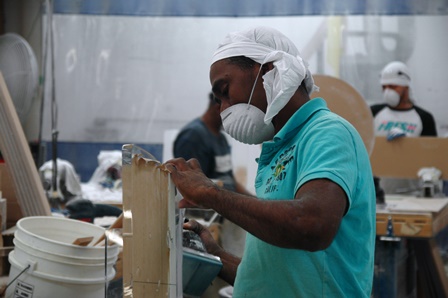Follow me @liamlaguerre
It’s been nearly six years since Allen Frechter moved his company, Plexi-Craft, to Long Island City.
Plexi-Craft, which was founded more than a half-century ago in Manhattan, makes acrylic furniture and displays.
Frechter took control in 2008 after his father passed away and he wanted to expand, but realized Manhattan was too expensive.
Frechter, who lives in Boston, thought about moving to Massachusetts. He also considered New Jersey and New Rochelle. But because of concern for his employees, and help from a local Industrial Business Zone (IBZ) manager in receiving incentives, he was drawn to LIC.
“We have guys [employees] that have been here for 35 years, and our average is about 10-12 years,” Frechter said. “If we had moved out of the city, these guys would have been out of jobs.”
Plexi-Craft currently employees 25 people, including 20 industrial workers, who cut, smooth and sort acrylic pieces. All of the employees live within the five boroughs.
Community leaders want companies such as Plexi-Craft, which is located in the LIC IBZ, to stay and grow in the city.
But some business owners and industry advocates say that their way of life is being threatened, since Mayor Bill de Blasio removed $1.1 million in funding for the IBZs from his preliminary budgets released last month.
The program was originally created to save and foster manufacturing and industrial jobs in the city, but funding has been reduced year after year.
The $1.1 million from last year’s budget was approved by the City Council in its revision, after then-Mayor Michael Bloomberg cut it from his budget. The City Council and de Blasio still have to make revisions to this year’s budget, so business owners hope the money will not only be replaced, but increased.
When Bloomberg created the IBZs in 2006, he allocated nearly $4 million to the program.
The money is used to give tax credits, up to $1,000 per employee if conditions are met, and pay for consulting services for IBZ managers, which businesses consider invaluable.
Many business owners are too preoccupied with running their establishments to figure out what they qualify for, and find it confusing to understand the alphabet soup of programs. That’s just one way IBZ managers try to help.
Spaeth Designs, a company that makes animated displays for stores during the holidays, including Macy’s, Saks Fifth Avenue, Lord & Taylor and Bloomingdale’s, is one such company. Spaeth Designs was located in Manhattan for about 40 years, until owners of the building they were in on 54th Street doubled the rent last year.
After talking with an IBZ manager in Queens, they decided to buy a building in Woodside, where the newly formed IBZ was affirmed.
The owners are depending on the IBZ manager to help figure out what incentive programs they qualify for. Since January, the company has been in the process of moving in to its new location.
“We were focused on getting the building and fixing it,” said Sandy Spaeth, president of Spaeth Designs. “What we need right now is to move in. As far as benefits go we don’t know yet.”
Spaeth employs about 30 worker at the height of its production season from July through November, and owners said their employees live in the five boroughs.
The other argument for the IBZs is that it will protect industrial businesses, since they are zoned for manufacturing companies.
David Spaeth, CEO and chairperson of Spaeth Designs, said the rent increase occurred because their former neighborhood was seeing an influx of luxurious businesses in other sectors. But in an IBZ, he argues, they won’t be pressured out.
“This is our home,” Spaeth said, “and for as long as we see it.”
RECOMMENDED STORIES































